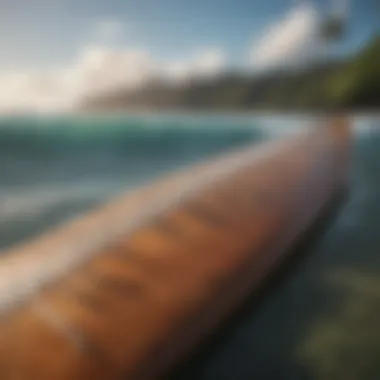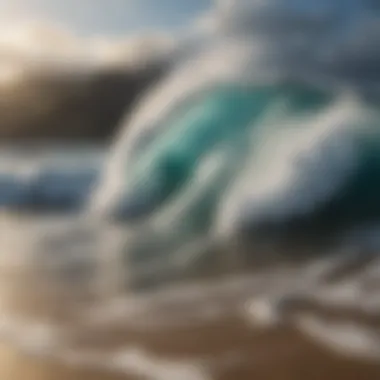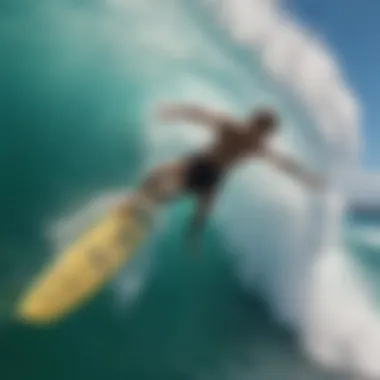Exploring the Depths of Hawaiian Surf Culture


Intro
Hawaiian surf culture is a unique and dynamic phenomenon that intertwines the elements of history, practice, and environmental impact. To truly grasp its essence, one must appreciate the intricacies that have shaped this sport over the decades. This article will provide a comprehensive analysis of Hawaiian surfing, its foundational philosophies, and how it continues to evolve in the modern era. By diving into its historical roots and contemporary practices, we hope to enlighten readers about the socio-cultural significance it holds in Hawaiian society.
The History of the Sport
Origin and Evolution
Surfing in Hawaii, known as heʻe nalu, has its origins deeply rooted in ancient Polynesian culture. It was more than just a sport; it was an integral part of social and political life. The first surfers used wooden boards, crafted from koa trees, showcasing both craftsmanship and a deep connection to nature.
Over the years, surf culture evolved, especially during the early 20th century when Duke Kahanamoku, an Olympic swimmer, popularized it beyond the islands. His influence helped bridge the gap between the indigenous practices and Western perceptions of surfing. This shift brought many newcomers to experience the waves, leading to increased interest in surf tourism.
Milestones and Influences
Significant milestones mark the growth of surfing in Hawaii. In the 1960s, the rise of surf films and magazines propelled the sport into a cultural spotlight, inspiring generations of surfers worldwide. Films like
Preface to Hawaiian Surf Culture
Hawaiian surf culture is not just a recreation; it intrinsically shapes the identity of the islands and its people. Roots of this culture run deep into Hawaii's history, with surfing dating back centuries. This section provides an overview of the significance of surfing in Hawaii, looking at its historical foundation and evolving techniques which have made it a global phenomenon.
Historical Significance of Surfing in Hawaii
Surfing in Hawaii began long before European contact, with ancient Polynesians practicing the sport as a means of recreation and social interaction. The first accounts of surfing appear in ancient Hawaiian chants and legends. It was a sport engaged not merely for enjoyment but also for social status. Chiefs would ride the largest waves, showcasing their strength and skill.
In the 19th century, surfing faced decline due to outside influences, including colonialism and missionary activities. Nevertheless, the cultural revival in the early 20th century led by figures such as Duke Kahanamoku was pivotal. Duke is hailed as the father of modern surfing, promoting the sport worldwide and contributing greatly to its resurgence.
Surfing in Hawaii is more than just riding waves; it is a manifestation of ancient traditions and community values, reflecting respect for nature and each other.
The historical lens through which one examines surfing reveals its significance in community bonding, spiritual practices, and cultural pride. Hawaiian surfing represents a unique blend of physical prowess and cultural reverence.
The Evolution of Surfing Techniques
As surfing gained global attention, various techniques and styles emerged. Early surfers rode large wooden boards, known as
Fundamental Principles of Surfing
Understanding the fundamental principles of surfing is essential for both newcomers and seasoned surfers. This topic highlights key components that contribute to a successful surfing experience. Mastering these elements ensures safety, enhances performance, and creates a fulfilling connection to the ocean. Surfing is not just an adventurous sport; it involves a deep relationship with nature and requires appreciation for its dynamics.
Understanding Wave Formation
Waves are the core of surfing. Their formation is influenced by various factors including wind speed, duration, and direction, as well as the shape of the ocean floor. Here’s a basic overview:
- Wind: As wind blows across the ocean, it transfers its energy to the water, creating waves.
- Fetch: The distance over which the wind travels affects the size of the waves. Longer fetch results in bigger waves.
- Seafloor: Reef breaks, beach breaks, or point breaks are influenced by underwater topography. Each type offers different riding conditions.
A deeper understanding of wave dynamics aids surfers in choosing the right time and location to surf. For example, the best waves often occur during storms due to the stronger winds causing increased wave heights.
Player Positioning and Balance
Achieving optimal player positioning is critical. Positioning involves knowing where to sit on your board and where to be in relation to the wave. Key points to consider include:


- Taking off: This refers to the moment you catch a wave. Aligning yourself just right increases your chance of a successful takeoff.
- Stance: Your body position and stance play a vital role in maintaining balance. An athletic stance with knees slightly bent helps absorb motion and maintain stability.
- Weight Distribution: Distributing your weight properly affects your control and speed on the wave. Leaning too far back may cause you to lose momentum, while leaning forward can lead to nosediving.
Balance is not just physical; it’s also about rhythm and timing with the wave. Surfers learn to read waves, adjusting their stance and center of gravity in response to changing conditions.
Technique and Timing
Technique is another pillar of surfing. Surfers must combine skillful body movement with good timing to ride waves effectively. Important elements include:
- Paddling: Efficient paddling techniques can make the difference between catching or missing a wave. Using long, deliberate strokes usually propels you forward more effectively.
- Pop-up: The transition from paddling to standing requires speed and fluid motion. The pop-up should be practiced extensively to achieve success under various conditions.
- Turning: As you ride a wave, turning is crucial for maneuvering and maintaining speed. Mastering turns can elevate your surfing ability significantly.
Timing is equally vital. Surfers must anticipate the wave's movements and react accordingly. This ability to synchronize movements with nature’s rhythm allows for a fluid, exhilarating experience.
“Surfing is not just about riding waves. It’s a mastery of nature and self.”
Surfboard Design and Innovation
Surfboard design is a cornerstone of today’s surfing experience. The development of surfboards over time reflects a blend of art, science, and the surfers' desire for performance. New materials, shapes, and technological advancements greatly enhance how surfers interact with the waves, making design innovation crucial to the sport's evolution.
Materials and Construction
Materials used in surfboard construction have advanced significantly. Traditional wood boards have given way to fiberglass and foam combinations, providing a balance of strength and weight. Modern surfboards often utilize materials like epoxy resin, which results in lighter and more durable boards compared to previous generations. This transformation is critical for performance.
Some common materials include:
- Polyurethane Foam: This is standard for many surfboards due to its lightness but is less durable in water compared to other options.
- Epoxy Resin: Reflecting in strength and buoyancy, these boards typically last longer and are less toxic to the environment.
- Carbon Fiber: A newer introduction in surfboard design, offering exceptional strength-to-weight ratios.
Additionally, construction techniques like vacuum forming and CNC shaping have increased precision in board production. This precision enhances performance, ensuring boards respond accurately to rider inputs.
Shape and Performance
The shape of a surfboard significantly influences its performance on the waves. Each design caters to different wave conditions and riding styles.
For example:
- A shortboard is designed for maneuverability and speed, suitable for small, fast waves.
- A longboard offers stability and ease in paddling, great for beginners or laid-back cruising.
- Fish and funboards bridge these styles, combining features that appeal to various skill levels.
Rocker (the curve of the board from nose to tail) also affects performance. A board with a high rocker will maneuver easily but may not maintain speed. Conversely, a flat board retains speed but is more challenging to turn. Thus, surfers must choose based on their preferred style and the conditions they are likely to encounter.
Customization Trends
Customization in surfboards is rising. Surfers desire boards that reflect personal style and meet specific needs. Many local shapers in Hawaii allow surfers to co-create their boards. This trend drives innovation.
Common customization options include:
- Modifying the size and shape tailored to their weight and skill level.
- Choosing artwork that resonates with their identity and culture. As surfing is significant in the Hawaiian identity, many surfers opt for designs that reflect their heritage.
- Experimenting with different fins to alter handling and stability characteristics.
Custom boards provide a unique connection between the surfer and their equipment, allowing for enhanced performance and personal expression. As surfing continues to evolve, the integration of innovative designs, sustainable materials, and personalized experiences will shape the future of surfing in Hawaii.
Ultimately, the surfboard is not just a tool. It is an extension of the surfer, a piece of art that tells a story and reflects a lifestyle deeply rooted in the Hawaiian culture.
Environmental Considerations in Surfing


Surfing is more than just a sport; it deeply entwines with the environment in which it takes place. Understanding the environmental considerations in surfing is crucial for preserving both the experience and the ecosystems involved. Hawaii, known for its breathtaking waves, also faces challenges that surfers, both local and visiting, need to acknowledge and address.
Impact of Surfing on Marine Ecosystems
Surfing affects marine ecosystems in multiple ways. When surfers enter the water, they interact directly with the ocean’s environment. This includes physical impacts from surfboards striking the water surface and reefs. The damage can be especially pronounced in fragile coral systems. These ecosystems are vital, serving as habitats for countless marine species. In addition, increased foot traffic and potential pollution can disrupt these habitats.
- Coral Damage: Surfers can unintentionally harm coral reefs. The fins of surfboards can scrape and damage these living structures.
- Water Contamination: Surfing areas can become polluted, particularly near beach facilities and urban runoff zones. This pollution can have dire consequences on marine life.
- Altered Ecosystems: The presence of surfers can change feeding patterns for fish and other marine animals. Surfers may inadvertently scare away species or introduce foreign practices that disrupt local wildlife activities.
Conservation Initiatives in Hawaii
Recognizing the environmental impact of surfing, numerous conservation initiatives have sprung up across Hawaii. These programs aim to protect marine life and ecosystems while promoting sustainable surfing practices.
- Education Programs: Many organizations focus on educating surfers about responsible practices. Proper surf etiquette and environmental awareness are key components of these programs.
- Beach Cleanups: Local surf communities often organize beach cleanups to combat pollution. These events build camaraderie and raise awareness about the importance of a clean environment.
- Protective Legislation: Hawaii has enacted various laws aimed at protecting marine ecosystems. Regulations on commercial fishing and coastal development serve to maintain the natural beauty and biological richness of the islands.
Community effort is vital in protecting our oceans. Every surfer has a role to play in conservation.
Overall, these initiatives underscore the importance of balancing passion for surfing with a commitment to environmental stewardship. Through awareness and action, surfers can contribute positively to the health of Hawaii's marine ecosystems, ensuring that future generations can also enjoy the waves that define surf culture in the islands.
The Role of Community and Lifestyle
Surfing in Hawaii is more than just a sport; it is an essential part of the lifestyle and community here. The sense of belonging that Hawaiian surf culture nurtures shapes the lives of many individuals. This sense of community is vital for both the preservation of surf traditions and the promotion of safety and well-being among surfers.
Surfing as a Way of Life
For many in Hawaii, surfing transcends the mere act of riding waves. It is a profound reflection of identity and connection to heritage. Local values, such as aloha and kuleana, emphasize respect and responsibility towards others and the environment. This philosophy manifests in surf practice where surfers honor ancient traditions, often engaging in rituals before heading out on the water.
Surfers regard the ocean as a living entity. They acknowledge its power and rhythm. This understanding brings them closer to nature and fosters a humble attitude. Surfing provides an avenue for community bonding. Gatherings at beaches, surf contests, and shared experiences create lasting friendships. It serves as a social equalizer, allowing individuals from diverse backgrounds to connect over their shared passion.
Local Surf Communities and Support Networks
The structure of local surf communities in Hawaii is intricate and supportive. These networks are fundamental in providing mentorship and guidance to newcomers and young surfers. Experienced surfers often take it upon themselves to teach and nurture the next generation. This fosters a deep sense of tradition, where knowledge and skills are passed down through generations.
Community events also play a key role. Local beaches often host surf competitions and festivals, celebrating talent and diversity. These events encourage participation from a range of surfers, showcasing their skills while promoting collaboration and friendship.
Additionally, social media platforms like Facebook and Reddit foster a virtual sense of community. Surfers use these channels to share tips, experiences, and advice. They also organize meet-ups and events, reducing feelings of isolation among surfers. Support networks are also apparent in advocacy, where communities come together to protect local surf spots from over-commercialization and environmental threats.
The strength of the Hawaiian surfing community lies in its commitment to mutual respect, understanding, and the preservation of a unique way of life.
Challenges Facing Hawaiian Surfing
The surfing community in Hawaii is rich and diverse, but it is not without its challenges. Understanding these issues is crucial for both participants and enthusiasts. This section will explore the intersection of tourism and surf etiquette, which significantly impact the local culture and environment.
Tourism and Its Impacts
Tourism is a double-edged sword for Hawaiian surfing. On one hand, it brings in revenue and a global spotlight, showcasing the beauty of the islands and the thrill of surfing to international audiences. On the other hand, it often leads to overcrowded beaches and surf spots, straining local resources and diminishing the experience for both locals and visiting surfers.
As more tourists flock to the islands, the competition for waves increases. This overcrowding has a negative effect on the surfing experience. It can lead to conflicts among surfers and may raise safety concerns due to high activity levels in the water. Additionally, with more people on the waves, there is an increased risk of environmental degradation. The influx of visitors can create waste, disturb marine life, and contribute to the wear and tear of natural habitats.
Local surfers often find themselves at odds with tourists who may not understand the cultural significance of certain surf spots. A lack of awareness about the sacredness of specific areas can result in disrespect or irresponsible behavior. Thus, while tourism has benefits, it also poses significant challenges that must be addressed to maintain the integrity of Hawaiian surf culture.


The Issue of Surf Etiquette
Surf etiquette is an essential aspect of Hawaiian surfing. It governs how surfers interact with each other on the water, ensuring respect and safety. However, with the rise in tourism, the understanding of surf etiquette has diminished among some visitors.
The core principles of surf etiquette include:
- Priority: The surfer closest to the peak of a wave has the right of way. It's essential for all surfers to be mindful and respectful of this.
- Paddle Out: Surfers should paddle out through the designated channels, which helps to avoid collisions with riders.
- Communicate: Body language and verbal signals are crucial for navigating crowded surf spots. Clear communication can prevent dangerous situations.
Newcomers often overlook these rules, which can lead to frustrating encounters in the water. Not just are these interactions potentially dangerous, they also create an uncomfortable environment for local surfers. Fostering an understanding of surf etiquette is critical to preserving the essence of Hawaiian surfing and ensuring that all participants can enjoy the experience respectfully.
Future of Surfing in Hawaii
The future of surfing in Hawaii carries significant weight in the broader narrative of Hawaiian surf culture. It is essential to explore what lies ahead for this vibrant community as technological advancements shape the way surfers interact with the ocean. This section focuses on how innovation can enhance both performance and safety while preserving the integrity of these treasured traditions. Furthermore, understanding how to sustain surf culture amidst changing landscapes and tourism pressures is paramount to ensuring that the essence of Hawaiian surfing remains vibrant.
Technological Advances and Their Implications
In recent years, technology has made substantial inroads into the world of surfing. Equipment design has evolved dramatically. Modern surfboards, for instance, utilize advanced materials and engineering methods. These innovations not only enhance performance but also contribute to the safety and enjoyment of the surfer.
Some prominent technological advancements include:
- Smart surfboards: These boards feature sensors that provide real-time data on a surfer's performance, tracking metrics like speed and maneuverability.
- Wave forecasting apps: Applications such as Surfline and Magicseaweed have revolutionized how surfers plan their sessions, offering precise forecasts and data on wave conditions.
- Eco-friendly materials: As environmental awareness grows, many manufacturers are experimenting with sustainable materials, reducing the ecological footprint of surfboard production.
Such developments underscore the balance between embracing innovation and respecting traditional practices. The challenge lies in integrating technology without undermining the cultural significance of surfing. This adaptation can enhance the overall experience while safeguarding the values ingrained in Hawaiian surf culture.
Sustaining Hawaiian Surf Culture
To safeguard the future of surfing in Hawaii, it is crucial to focus on sustainability. This involves maintaining the delicate ecosystem that supports the reefs, beaches, and waves. With the impacts of climate change and tourism threatening these natural resources, proactive measures are necessary.
Key considerations for sustainability include:
- Education and advocacy: Promoting awareness about environmental preservation is vital for local communities and visitors alike. Surf schools and local organizations can play a significant role.
- Responsible tourism practices: Encouraging surfers to respect local surf etiquette and the environment helps mitigate the adverse effects of tourism on surf spots.
- Community engagement: Fostering a sense of ownership among locals can enhance stewardship of the oceans and promote sustainable practices that benefit everyone.
Addressing these issues holistically ensures that Hawaiian surf culture continues to thrive. The fusion of traditional values and modern innovation can pave the way for a vibrant and sustainable future.
"To respect the ocean is to respect the culture that has grown around it; the two are intertwined in a profound way."
Investing in cultural preservation and environmental sustainability is not merely an option but a necessity for the future of surfing in Hawaii. By doing so, the essence of the sport, which has been ingrained in Hawaiian identity for generations, can endure for years to come.
Epilogue
In examining Hawaiian surf culture, we recognize its significance not only as a sport but also as a rich tapestry of tradition, innovation, and community. The narrative explored throughout this article highlights several key elements: the historical roots of surfing, its evolution in techniques and equipment, the impact of environmental factors, and the future prospects. These layers contribute to a deeper understanding of surfing as an integral part of Hawaiian identity.
The relevance of these topics extends beyond mere recreational activity. It sheds light on cultural preservation efforts, as the younger generation strives to maintain the authenticity of values ingrained in surfing. Moreover, discussing sustainability allows surfers and enthusiasts to become more mindful of their environmental impact, ensuring that a balance exists between enjoyment and conservation.
Here are some important aspects covered in this article:
- The deep historical significance and evolution relate directly to today’s practices.
- Techniques discussed provide insight into the skills necessary for mastering the waves.
- Environmental considerations underscore the importance of protecting marine ecosystems.
- The socio-cultural implications illustrate how surfing is intertwined with Hawaiian traditions.
Overall, the future of Hawaiian surf culture depends on embracing innovation while respecting the past. Only by understanding these nuances can individuals appreciate the fullness of what surfing represents in Hawaii today.
Reflections on the Future
Considering the future of Hawaiian surf culture conjures thoughts about how it will adapt in an ever-changing world. With the arrival of new technologies, the expectations from participants change, making innovations in surf equipment pivotal. Surfboards are now tailored to enhance performance, leading to greater accessibility for both amateurs and experts alike.
There’s also a growing recognition of the need to protect the environment. Initiatives surrounding conservation have gained momentum, creating a sense of responsibility among surfers. This prioritization highlights a desire to safeguard not only the waves but also the broader marine ecosystems that sustain them.
In summary, to remain vibrant, Hawaiian surf culture must navigate the challenges posed by modernization while cherishing its deep roots. Adjustments in practices, greater community engagement, and sustainability efforts will serve as essential components in shaping its continued relevance.







